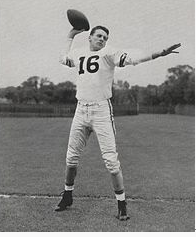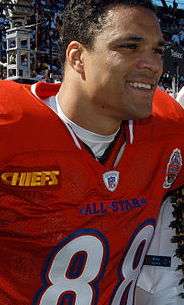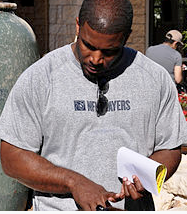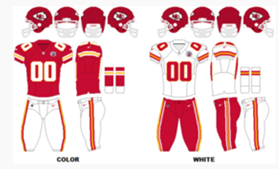
The Kansas City Chiefs are a professional American football team based in Kansas City, Missouri. They are a member of the Western Division of the American Football Conference (AFC) in theNational Football League (NFL). Originally named the Dallas Texans, the club was founded by Lamar Hunt in 1960 as a charter member of the American Football League (AFL). In 1963, the teamrelocated to Kansas City and assumed their current name. They joined the NFL during the AFL–NFL merger of 1970. The team is legally and corporately registered as Kansas City Chiefs Football Club, Incorporated and according to Forbes is valued at just under USD 1 billion.[2]
From 1960 to 1969, the Chiefs were a successful franchise in the AFL, winning three league championships (in 1962, 1966 and 1969) and having an all-time AFL record of 92–50–5.[3] The Chiefs were the second AFL team (after the New York Jets) to defeat an NFL franchise in an AFL–NFL World Championship Game when they defeated the Minnesota Vikings in Super Bowl IV. The team's victory on January 11, 1970 remains the club's last championship game victory and appearance to date. The Chiefs were the second team, after the Green Bay Packers, to appear in more than one Super Bowl, and they were the first team to appear in the championship game in two different decades.
Franchise history
Further information: History of the Kansas City Chiefs
1960–88
1960s
In 1959 Lamar Hunt began discussions with other businessmen to establish a professional football league that would rival the National Football League.[3][4] Hunt's desire to secure a football team was heightened after watching the 1958 NFL Championship Game between the New York Giants and Baltimore Colts.[4][5] After unsuccessful attempts to purchase and relocate the NFL's Chicago Cardinalsto his hometown of Dallas, Texas,[3][6] Hunt went to the NFL and asked to create an expansion franchise in Dallas. The NFL turned him down, so Hunt then established the American Football Leagueand started his own team, the Dallas Texans, to begin play in 1960. Hunt hired a little-known assistant coach from the University of Miami football team, Hank Stram, to be the team's head coach.[4] Hunt chose Stram after the offer was declined by Bud Wilkinson and Tom Landry.[4]
Also hired was Don Klosterman as head scout, credited by many for bringing a wealth of talent to the Texans after luring it away from the NFL, often hiding players and using creative means to land them.

Len Dawson was the Chiefs Hall of Fame quarterback.
The Texans shared the Cotton Bowl with the NFL's cross-town competition Dallas Cowboys for three seasons.[4] While the team averaged a league-best 24,500 at the Cotton Bowl, the Texans gained less attention due to the league's relatively unknown existence.[4] In the franchise's first two seasons, the team managed only a 14–14 record.[7] In their third season, the Texans strolled to an 11–3 record and a berth in the team's first American Football League Championship Game, against the Houston Oilers.[6][7] The game was broadcast nationally on ABC and the Texans defeated the Oilers 20–17 in double overtime.[6] The game lasted 77 minutes and 54 seconds, which still stands as the longest championship game in professional football history.[6]
Despite having a championship team in the Texans and a Cowboys team that managed only a 9–28–3 record in their first three seasons, the Dallas–Fort Worth media market could not sustain two professional football franchises.[6][8] Hunt became interested in moving the Texans to either Atlanta, Georgia or Miami, Florida for the 1963 season.[6] Mayor of Kansas City Harold Roe Bartle extended an invitation to Hunt to move the Texans to Missouri.[6][8][9] Bartle promised to triple the franchise's season ticket sales and expand seats at Municipal Stadium to accommodate the team.[6][8][9]
Hunt agreed to relocate the franchise to Kansas City on May 22, 1963 and on May 26 the team was renamed the Kansas City Chiefs.[6][8][9] Hunt and head coach Hank Stram initially planned on retaining the Texans name, but a fan contest determined the new "Chiefs" name in honor of Mayor Bartle's nickname that he acquired in his professional role as Scout Executive of the St. Joseph and Kansas City Boy Scout Councils and founder of the Scouting Society, the Tribe of Mic-O-Say.[6][9][10]A total of 4,866 entries were received with 1,020 different names being suggested, including a total of 42 entrants who selected "Chiefs."[10] The two names that received the most popular votes were "Mules" and "Royals."[10]
The franchise became one of the strongest teams in the now thriving American Football League,[3] with the most playoff appearances for an AFL team (tied with theOakland Raiders), and the most AFL Championships (three).[6] The team's dominance helped Lamar Hunt become a central figure in negotiations with NFL Commissioner Pete Rozelle to agree on an AFL–NFL merger.[6][11] In the meetings between the two leagues, a merged league championship game was agreed to be played in January 1967 following the conclusion of the leagues' respective 1966 seasons. Hunt insisted on calling the game the "Super Bowl" after seeing his children playing with a popular toy at the time, a Super Ball.[6][11][12] While the first few games were designated the "AFL–NFL World Championship Game," the Super Bowl name became its officially licensed title in years to come.
The Chiefs cruised to an 11–2–1 record in 1966, and defeated the defending AFL Champion Buffalo Bills in the AFL Championship Game.[13] The Chiefs were invited to play the NFL's league championGreen Bay Packers in the first AFL–NFL World Championship Game. Kansas City and Green Bay played a close game for the first half, but Green Bay took control in the final two quarters, winning the game by a score of 35–10.[6] The Chiefs lost the game but gained the respect of several Packers opponents following the game.[14] The Chiefs' interleague match-up with the Packers was not the last time that they would face an NFL opponent, especially on the championship stage.[6] The following August, Kansas City hosted the NFL's Chicago Bears in the 1967 preseason and won the game 66–24.[6]
Despite losing to the division rival Oakland Raiders twice in the regular season in 1969, the two teams met for a third time in the AFL Championship Game where Kansas City won 17–7.[7] Backup quarterback Mike Livingston led the team in a six-game winning streak after Len Dawson suffered a leg injury which kept him out of most of the season's games.[6] While getting plenty of help from the club's defense, Dawson returned from the injury and led the Chiefs to Super Bowl IV.[6] Against the NFL champion Minnesota Vikings,[3] who were favored by 12½, the Chiefs dominated the game 23–7 to claim the team's first Super Bowl championship.[6] Dawson was named the game's Most Valuable Player after completing 12-of-17 passes for 142 yards and one touchdown, with 1 interception.[15] The following season, the Chiefs and the rest of the American Football League merged with the National Football League after the AFL–NFL merger became official.[6] The Chiefs were placed in the American Football Conference's West Division.[7]
From 1960–1969, the Chiefs/Texans had won 87 games, most in AFL history.[16]
1970s
In 1970, the Chiefs won only seven games in their first season in the NFL and missed the playoffs.[7] The following season, the Chiefs tallied a 10–3–1 record and won the AFC West Division.[17] Head coach Hank Stram considered his 1971 Chiefs team as his best, but they failed to capture their championship dominance from 1969.[17] Most of the pieces of the team which won Super Bowl IV two years earlier were still in place for the 1971 season.[17] The Chiefs tied with theMiami Dolphins for the best record in the AFC, and both teams met in a Christmas Day playoff game which the Chiefs lost 27–24 in double overtime.[17] The Dolphins outlasted the Chiefs with a 37-yard field goal.[17] The game surpassed the 1962 AFL Championship Game as the longest ever at 82 minutes and 40 seconds.[17] The game was also the final football game at Kansas City's Municipal Stadium.[17]
In 1972, the Chiefs moved into the newly constructed Arrowhead Stadium at the Truman Sports Complex outside of Downtown Kansas City.[17] The team's first game at Arrowhead was against the St. Louis Cardinals, a game which the Chiefs won 24–14.[17] Linebacker Willie Lanier and quarterback Len Dawson won the NFL Man of the Year Award in 1972 and 1973, respectively. The Chiefs would not return to the post-season for the remainder of the 1970s, and the 1973 season was the team's last winning effort for seven years.[17] Hank Stram was fired following a 5–9 season in 1974, and many of the Chiefs' future Hall of Fame players would depart by the middle of the decade.[17] From 1975 to 1988, the Chiefs had become a laughing stock of the NFL and provided Chiefs fans with nothing but futility.[18][19] Five head coaches struggled to achieve the same success as Stram, compiling an 81–121–1 record.[18]
1980–1988
In 1981, running back Joe Delaney rushed for 1,121 yards and was named the AFC Rookie of the Year.[20] The Chiefs finished the season with a 9–7 record and entered the 1982 season with optimism.[20] However, the NFL Players Association strike curbed the Chiefs' chances of returning to the postseason for the first time in over a decade.[20] By employing replacement players, the Chiefs tallied a 3–6 record[7] and in the off-season, Joe Delaney died while trying to save several children from drowning in a pond near his home in Louisiana.[21]
The Chiefs made a mistake in drafting quarterback Todd Blackledge over future greats such as Jim Kelly and Dan Marino in the 1983 NFL Draft.[22][23] Blackledge never started a full season for Kansas City while Kelly and Marino played Hall of Fame careers.[23] While the Chiefs struggled on offense in the 1980s, the Chiefs had a strong defensive unit consisting of Pro Bowlers such as Bill Maas, Albert Lewis, Art Still and Deron Cherry.[20]
John Mackovic took over head coaching duties for the 1983 season after Marv Levy was fired.[20] Over the next four seasons, Mackovic coached the Chiefs to a 30–34 record, but took the team to its first post-season appearance in 15 years in the 1986 NFL playoffs.[7] Following the team's loss to the New York Jets in the playoffs, Mackovic was fired.[20] Frank Gansz served as head coach for the next two seasons, but won only eight of 31 games.[20]
1989–2008
On December 19, 1988, owner Lamar Hunt hired Carl Peterson as the team's new president, general manager, and chief executive officer. Peterson fired head coach Frank Gansz two weeks after taking over and hired Marty Schottenheimer as the club's seventh head coach.[20] In the 1988 and 1989 NFL Drafts, the Chiefs selected both defensive end Neil Smith and linebacker Derrick Thomas, respectively.[20][24] The defense that Thomas and Smith anchored in their seven seasons together was a big reason why the Chiefs reached the postseason in six straight years.[25]
In Schottenheimer's tenure as head coach (1989–1998), the Chiefs became a perennial playoff contender, featuring offensive players including Steve DeBerg, Christian Okoye, Stephone Paige and Barry Word, and a strong defense, anchored by Thomas, Smith, Albert Lewis and Deron Cherry.[3] The team recorded a 101–58–1 record, and clinched seven playoff berths.[26] The Chiefs' 1993 season was the franchise's most successful in 22 years.[24] With newly-acquired quarterback Joe Montana and running back Marcus Allen—two former Super Bowl champions and MVP's—the Chiefs further strengthened their position in the NFL.[24] The 11–5 Chiefs defeated the Pittsburgh Steelers and Houston Oilers on their way to the franchise's first and to date only AFC Championship Game appearance against the Buffalo Bills.[24] The Chiefs were overwhelmed by the Bills and lost the game by a score of 30–13.[24] The Chiefs' victory on January 14, 1994 against the Oilers remains the franchise's last post-season victory to date.
In the 1995 NFL playoffs, the 13–3 Chiefs hosted the Indianapolis Colts in a cold, damp night game at Arrowhead Stadium.[7][24] Kansas City lost the game 10–7 against the underdog Colts after kicker Lin Elliot missed three field goal attempts and quarterback Steve Bono threw three interceptions.[24] The Chiefs selected tight end Tony Gonzalez with the 13th overall selection in the 1997 NFL Draft, a move which some considered to be a gamble being that Gonzalez was primarily a basketball player at California. During a 1997 season full of injuries to starting quarterback Elvis Grbac, backup quarterback Rich Gannon took the reins of the Chiefs' offense as the team headed to another 13–3 season.[7][24]Head coach Marty Schottenheimer chose Grbac to start the playoff game against the Denver Broncos despite Gannon's successes in previous weeks.[24] Grbac's production in the game was lacking, and the Chiefs lost to the Broncos 14–10.[24]Denver went on to capture their 6th AFC Championship by defeating Pittsburgh, and then defeated the Green Bay Packers in Super Bowl XXXII.
Coach Schottenheimer announced his resignation from the Chiefs following the 1998 season, and defensive coordinator Gunther Cunningham took over coaching duties for the next two seasons, compiling a 16–16 record.[24] By the end of the Chiefs' decade of regular-season dominance, Gannon had signed with the Oakland Raiders, Neil Smith signed with the Denver Broncos, and Derrick Thomas was paralyzed from a car accident on January 23, 2000.[24] Thomas died from complications of his injury weeks later.[24] After allegedly reading online that he would be relieved of duties, head coach Gunther Cunningham was fired.[27][28]

Tony Gonzalez at the 2005 Pro Bowl.

Priest Holmes became one of the league's top backs in the early 2000s.
Looking to change the Chiefs' game plan which relied on a tough defensive strategy for the past decade, Carl Peterson contacted Dick Vermeil about the Chiefs' head coaching vacancy for the 2001 season.[27] Vermeil previously led the St. Louis Rams to a victory in Super Bowl XXXIV.[28] Vermeil was hired on January 12. The Chiefs then traded a first round draft pick in the 2001 NFL Draft to St. Louis for quarterback Trent Green and signed free agent running back Priest Holmes to be the team's cornerstones on offense.[28]





















